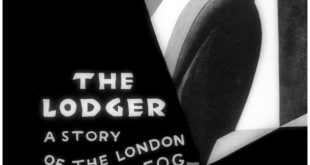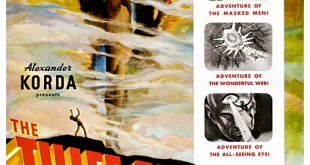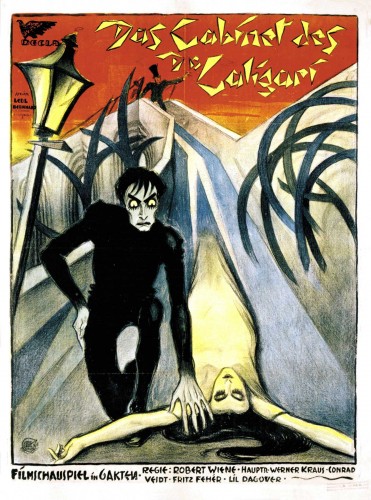 SYNOPSIS:
SYNOPSIS:
“A horror film that surpasses all others. Alan relates the story of traveling magician Doctor Caligari and Cesare. Their arrival in a town coincides with savage killings. Secretly Caligari was an asylum director who hypnotizes Cesare to murder. But the final reel contains something which will leave an audience shattered. It blows away all your moral certainties and beliefs. This is the true power of its horror. To leave you vulnerable and uncertain of what you feel was secure and certain.” (courtesy IMDB)
REVIEW:
Now, I know I’m prone to saying this, but in this case it’s absolutely true. This week I have a true classic of cinema. No, I’m not kidding. Look, just to show you how serious I am, it’s a silent film and in black-and-white, so don’t adjust your sets, though you may want to turn the sound off and add your own soundtrack – no Pink Floyd, though. So, now I’m proud, no, privileged to introduce to you one of the most influential horror films of all time. Ladies, gentlemen and Myspace users, let us now open The Cabinet Of Doctor Caligari (1919). I mean it, no Pink Floyd – and no Rick Wakeman, either.
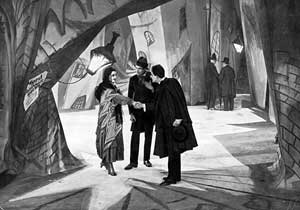 As you will see, The Cabinet Of Doctor Caligari was filmed on location in the little town of Holstenwall, known for its silly hats and lack of building codes. You don’t want to ask directions there. “The town hall? Straight down the crooked path, past the topsy-turvy house, turn left at the clockwise spiral, but not the counter-clockwise spiral, that’ll take you straight to the fairground.”
As you will see, The Cabinet Of Doctor Caligari was filmed on location in the little town of Holstenwall, known for its silly hats and lack of building codes. You don’t want to ask directions there. “The town hall? Straight down the crooked path, past the topsy-turvy house, turn left at the clockwise spiral, but not the counter-clockwise spiral, that’ll take you straight to the fairground.”
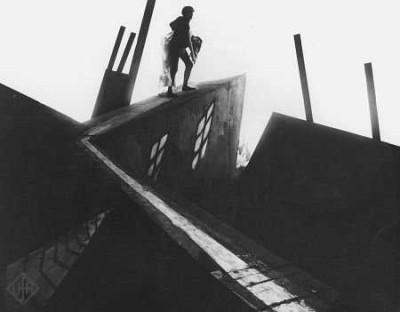 The Cabinet Of Doctor Caligari, and its lesser-known sequel The Sideboard Of Doctor Caligari, was directed by Robert Wiene, who made a lot of films in Germany before unaccountably moving overseas in 1933 to work. Werner Krauss, who plays Caligari, elected to stay in Germany where he was quite happy to continue working in the film industry, especially under the country’s change in management. Conrad Veidt, who plays Cesare, was not quite as amiable, moving to America where he appeared in such traitorous films as Casablanca (1942) – did he have no respect for his homeland? Strangely enough, Veidt did play a Nazi officer in Casablanca, whilst Krauss received acclaim for his performance as a Jew in the documentary Jud Suss (1940). Conrad Veidt was also in The Man Who Laughs (1928). His disfigured visage inspired one of the greatest comic book villains of all-time, Dick Cheney…I mean, The Joker.
The Cabinet Of Doctor Caligari, and its lesser-known sequel The Sideboard Of Doctor Caligari, was directed by Robert Wiene, who made a lot of films in Germany before unaccountably moving overseas in 1933 to work. Werner Krauss, who plays Caligari, elected to stay in Germany where he was quite happy to continue working in the film industry, especially under the country’s change in management. Conrad Veidt, who plays Cesare, was not quite as amiable, moving to America where he appeared in such traitorous films as Casablanca (1942) – did he have no respect for his homeland? Strangely enough, Veidt did play a Nazi officer in Casablanca, whilst Krauss received acclaim for his performance as a Jew in the documentary Jud Suss (1940). Conrad Veidt was also in The Man Who Laughs (1928). His disfigured visage inspired one of the greatest comic book villains of all-time, Dick Cheney…I mean, The Joker.
 Some of you with one of those new whiz-bang plasma telly-thingos may be trying to adjust the convergence of the image to straighten out the architecture – don’t. The film was made like that deliberately. It is the first example of German Expressionism in cinema, so you’re going to have to use the Expressionism knob which, as far as I know, is only available on the new Sony model. You may also be wondering why people would go to a fun-fair to see a somnambulist. Somnambulism was a big thing in post-World War One Germany, as it is now. People were so starved of entertainment back then that a somnambulist was the equivalent of a U2 concert, again, as it is now.
Some of you with one of those new whiz-bang plasma telly-thingos may be trying to adjust the convergence of the image to straighten out the architecture – don’t. The film was made like that deliberately. It is the first example of German Expressionism in cinema, so you’re going to have to use the Expressionism knob which, as far as I know, is only available on the new Sony model. You may also be wondering why people would go to a fun-fair to see a somnambulist. Somnambulism was a big thing in post-World War One Germany, as it is now. People were so starved of entertainment back then that a somnambulist was the equivalent of a U2 concert, again, as it is now.
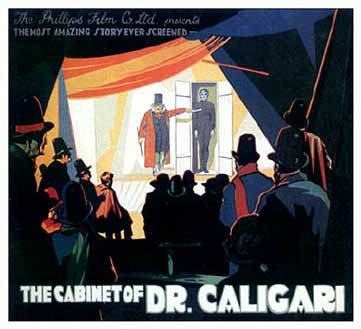 The Cabinet Of Doctor Caligari, as well as being the first true horror film ever made, it was also one of the most influential. You may recognise that some of the scenes are quoted in later horror films like Nosferatu (1922), Night Of The Living Dead (1968) and The Sound Of Music (1965). Unfortunately Robert Weine died whilst working on a sound remake with Jean Cocteau, so you’ll have to make do with the 1962 remake with Dan O’Herlihy as Doctor Caligari, or the 2005 remake with Doug Jones, of Pan’s Labyrinth (2006) and Silver Surfer fame, as Cesare, or indeed Doctor Caligari (1989) directed by Rinse Dream, the director of Cafe Flesh (1982). And look for my cameo in the real Doctor Caligari’s office.
The Cabinet Of Doctor Caligari, as well as being the first true horror film ever made, it was also one of the most influential. You may recognise that some of the scenes are quoted in later horror films like Nosferatu (1922), Night Of The Living Dead (1968) and The Sound Of Music (1965). Unfortunately Robert Weine died whilst working on a sound remake with Jean Cocteau, so you’ll have to make do with the 1962 remake with Dan O’Herlihy as Doctor Caligari, or the 2005 remake with Doug Jones, of Pan’s Labyrinth (2006) and Silver Surfer fame, as Cesare, or indeed Doctor Caligari (1989) directed by Rinse Dream, the director of Cafe Flesh (1982). And look for my cameo in the real Doctor Caligari’s office.
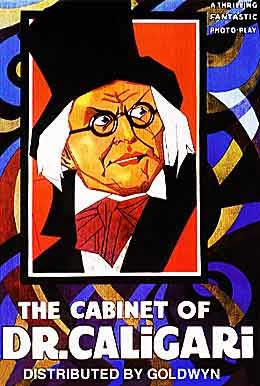 So once more good triumphs over evil and order is restored to the world – wait a minute – wrong film, sorry. Once more the film is revealed to be the ravings of a madman – that’s better. Did you notice me hanging around the doctor’s office near the end of the film? Easiest twenty marks I’ve ever made. I was paid more than Conrad Veidt. When he complain to Robert Weine, Weine reminded him that all he did was sleepwalk through the film. So join me next week as I ask you to attach the antenna to your car aerial, turn your headlights off, and don’t forget to attend the snack bar as I discuss Drive-In Massacre (1976). Till then, toodles!
So once more good triumphs over evil and order is restored to the world – wait a minute – wrong film, sorry. Once more the film is revealed to be the ravings of a madman – that’s better. Did you notice me hanging around the doctor’s office near the end of the film? Easiest twenty marks I’ve ever made. I was paid more than Conrad Veidt. When he complain to Robert Weine, Weine reminded him that all he did was sleepwalk through the film. So join me next week as I ask you to attach the antenna to your car aerial, turn your headlights off, and don’t forget to attend the snack bar as I discuss Drive-In Massacre (1976). Till then, toodles!
The Cabinet Of Doctor Caligari (1919)
 Horror News | HNN Official Site | Horror Movies,Trailers, Reviews
Horror News | HNN Official Site | Horror Movies,Trailers, Reviews


